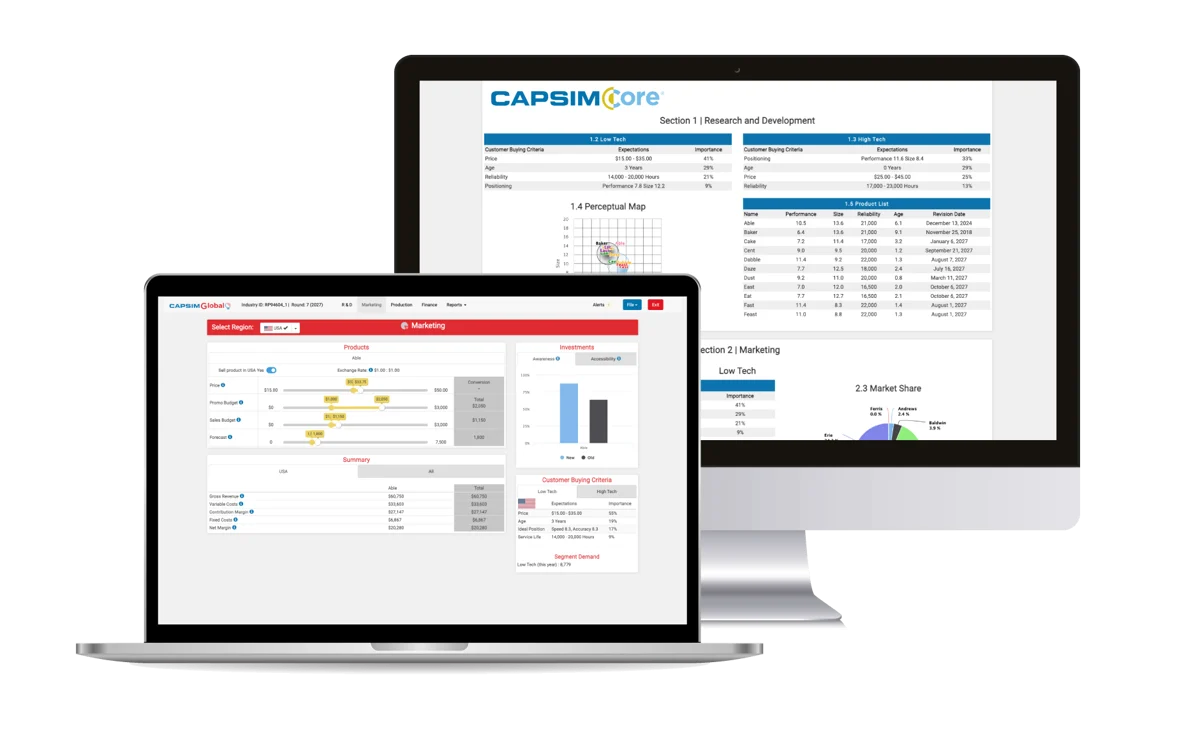What is the Contribution Margin and what are the different ways to increase your contribution margin in Capsim?
Published by Admin @

What is the Contribution Margin?
Financial analysis and managerial accounting rely on contribution margin. This is the revenue left after variable expenses of producing products or services. In other words, it's the money available to pay fixed expenditures and boost firm profits. The formula for calculating contribution margin: Revenue - Variable Costs = Contribution Margin Terms breakdown:
1. Revenue: Total sales from products or services.
2. Variable Costs: These expenses depend on production or sales. Raw materials, direct labor, and production-related variable overhead are examples.
Cash or revenue percentages can be used to calculate contribution margin. Divide contribution margin by revenue to get the contribution margin ratio: Revenue / Contribution Margin * 100%
The contribution margin helps companies assess product profitability and choose pricing, mix, and cost. It displays how much each item sells for fixed costs and profit. Contribution margins increase revenue to cover fixed expenses and boost net income, improving profitability.
Different ways to increase and manage your contribution margin in Capsim
Below are the different strategies, which one can use to increase its contribution margin in Capsim. sometimes, it is very hard for the students to manage their contribution margin while doing their Capsim business simulation.
1. Product Pricing and Position:
Assess market demand and competition to place your items optimally. Consider quality, features, and client tastes. Price your things according to their value. Premium positioning allows for higher pricing, which may increase contribution margins if customers see value.
2. Cost-Control and Efficiency:
Analyze your manufacturing processes to find ways to enhance them. Reduce waste and maximize resource use with lean manufacturing. Negotiate bulk purchase discounts and extended payment periods with vendors.
3. Product Differentiation:
R&D helps you innovate and stand out from the competition. Focus on things clients appreciate and will pay more for. Stay ahead of changing tastes by monitoring market trends and client input.
4. Scale economies:
For economies of scale, strategically increase output. Watch demand estimates to minimize overproduction, which increases inventory and storage expenses. Automation and technological enhancements can boost manufacturing efficiency.
5. Market and Sell:
Create efficient marketing efforts to increase product awareness and demand. Sales training and incentives can help your team meet sales goals. Explore distributor or retailer relationships to extend your reach and market penetration.
6. Manage Inventory:
Track and optimize stocks with inventory management systems. Reduce holding expenses and assure product availability with JIT inventory. Demand analysis and production planning prevent stockouts and surplus inventories.
7. Supplier Relations:
Strengthen supplier relationships via trust and collaboration. Seek mutually beneficial strategic relationships or cooperative projects. Monitor supplier performance and negotiate agreements to get good prices and terms.
8. Improve continuously:
Promote continual improvement in your company by encouraging staff to find and execute efficiency benefits. Train and develop employees to improve their skills. Use performance indicators and stakeholder feedback to adjust procedures regularly.
9. Product Mix Optimization:
Check each product line's profitability and focus on high-margin items. Consider adding new items or line extensions that complement your portfolio and serve other markets. To better manage resources, discontinue or reposition failing items.
10. Manage finances:
Create comprehensive financial models to assess and predict performance in various circumstances. Strategically invest in activities that can boost contribution margins. To maximize profitability and shareholder value, track important financial KPIs and make data-driven choices.
These techniques can boost your company's contribution margin, profitability, and market share in Capsim if used carefully and regularly. If you still have any confusion about doing your capsim, you can contact us anytime.




